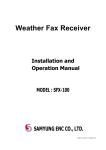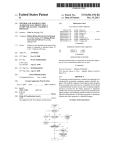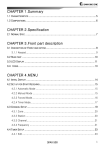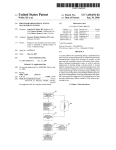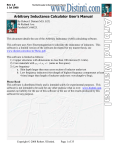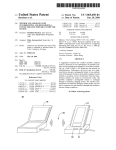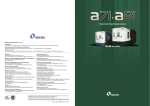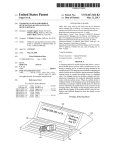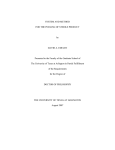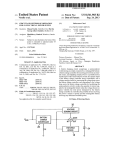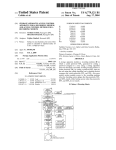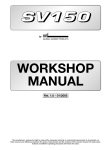Download User-controllable connectivity engine for electronic design
Transcript
US008584077B1 (12) United States Patent Kumar et a]. (54) USER-CONTROLLABLE CONNECTIVITY ENGINE FOR ELECTRONIC DESIGN AUTOMATION TOOLS (75) Inventors: Arbind Kumar, New Delhi (IN); John Robert Lefebvre, II, Atlanta, GA (US); Krishna Kumar Banka, Haryana (IN); Peter Niday, Genoa, NV (US) US 8,584,077 B1 (10) Patent N0.: (45) Date of Patent: Nov. 12, 2013 6,513,147 B1* 1/2003 6,857,110 B1* 2/2005 Rupp et a1. Nakatsu et a1. ............. .. 716/120 7,016,794 B2* 3/2006 716/136 Schultz ......................... .. 702/64 7,353,482 B2 4/2008 Murakawa 7,707,495 B2* 4/2010 Hosotsubo .................. .. 715/243 8,046,730 B1 10/2011 Ferguson et al. 8,136,076 B2* 3/2012 Bachina et a1. 2009/0319975 A1* 2010/0100862 716/126 12/2009 Huynh et a1. .. 4/2010 Ohtsuka 2013/0125078 A1* 5/2013 Bosshart ..................... .. 716/126 (73) Assignee: Agilent Technologies, Inc., Santa Clara, ... ... 716/10 A1* . . . .. 716/13 OTHER PUBLICATIONS CA (US) Notice: Subject to any disclaimer, the term of this patent is extended or adjusted under 35 U.S.C. 154(b) by 0 days. Filed: (51) Int. Cl. * cited by examiner Jul. 30, 2012 G06F 17/50 (52) Primary Examiner * Phallaka Kik (57) (2006.01) US. Cl. CPC ...... .. G06F 17/5077 (2013.01); G06F 17/5022 (2013.01); G06F17/505 (2013.01); G06F 17/5072 (2013.01); G06F 17/508] (2013.01) USPC ......... .. 716/139; 716/102; 716/118; 716/126; 716/138; 703/14 (58) Field of Classi?cation Search CPC ............ .. G06F17/5022; G06F17/505; G06F 17/5072; G06F17/5077; G06F 17/5081 USPC Microwave Of?ce Training, Feb. 15, 2008, Advancing the Wireless Revolution, 15 pages. (21) Appl. No.: 13/562,173 (22) NioPluse User Manual Version 2.0.1 (Draft), Apr. 26, 2012, NioPulse, 273 pages. ........... .. 716/139,102,118,126,138;703/14 See application ?le for complete search history. ABSTRACT A method for operating a computer system to generate a layout of a device and a computer-readable medium contain ing instructions that cause a computer system to carry out that method are disclosed. The computer system has a display that includes a display area. The computer system provides a list of objects and creates user selected objects from the list for inclusion in the display area. The computer assigns one of a plurality of operating modes for each connectivity object in the layout. The computer generates a Net assignment for each connectivity object that is not forced to have a speci?c Net assignment and for which automatic assignment of a Net is allowed. The computer generated assignment depends on the References Cited operating mode associated with that connectivity object. The U.S. PATENT DOCUMENTS operating mode of at least one of the connectivity objects can be altered by input from a user of said computer system. (56) 5,414,809 A * 5/1995 Hogan et al. ................ .. 715/765 6,240,541 B1* 5/2001 Yasuda et al. ............... .. 716/112 20 Claims, 12 Drawing Sheets [- 85 CREATE NET ASSIGNMENTS FOR ORPHANED CONECTIVITY MORE BRANCHES TO PROCE S S? OBJECTS HAVING THE "CREATE" ISOLATION MODE 1 MARK ALL CONNECTIVITY OBJECTS ON CURRENT BRANCH THAT ARE CAPABLE OF CHANGING NET ASSIGNMENTS AUTO-REMOVE NETS FROM ORPHANED CONNECTIVITY OBJECTS V 81 V82 CHANGE NET ASSIGNMENTS FOR CONNECTIVITY OBJECTS ON CURRENT BRANCH HAVING OPERATING MODES SET v83 DONE US. Patent NOV. 12, 2013 US 8,584,077 B1 Sheet 1 0f 12 <HEDGE \ \\\m?\ \ OHEDGE ,~ \ \ \ \\ \ \ \ I US. Patent Nov. 12, 2013 Sheet 2 0f 12 US 8,584,077 B1 2AFIGURE US. Patent Nov. 12, 2013 Sheet 3 0f 12 US 8,584,077 B1 2BFIGURE US. Patent Nov. 12, 2013 Sheet 4 0f 12 US 8,584,077 B1 3FIGURE US. Patent Nov. 12, 2013 Sheet 5 0f 12 US 8,584,077 B1 4FIGURE US. Patent Nov. 12, 2013 Sheet 6 0f 12 US 8,584,077 B1 F5IGURE US. Patent Nov. 12, 2013 Sheet 7 0f 12 US 8,584,077 B1 6AFIGURE U S. Patent NOV. 12, 2013 Sheet 8 0f 12 US 8,584,077 B1 m5EDGE HNUyMmEkZa OZ US. Patent Nov. 12, 2013 Sheet 11 0f 12 US 8,584,077 B1 VQ p61 DISPLAY 60 64 _/ COMPUTER KEYBOARD 9FIGURE US. Patent NOV. 12, 2013 Sheet 12 0f 12 US 8,584,077 B1 om 3 /. H“MmU@2<h4Mm3HO mZ"PWZ mrUiO 2EDGE QMUleanOw/H I o . mm US 8,584,077 B1 1 2 USER-CONTROLLABLE CONNECTIVITY ENGINE FOR ELECTRONIC DESIGN AUTOMATION TOOLS puter generated assignment depends on the operating mode associated with that connectivity object. The operating mode BACKGROUND In one aspect of the invention, de?ning the plurality of connectivity objects includes providing a list of objects in a of at least one of the connectivity objects can be altered by input from a user of said computer system. user selectable format, including connectivity objects, that Electronic design automation (EDA) tools are used to may be placed in said display area and included in said layout; facilitate the design and testing of complex electronic cir cuitry. These systems provide tools for inputting both the and selecting a connectivity object from the list based on user input. schematic drawing for a circuit and the layout of the actual In one aspect of the invention, one of the modes prevents the computer from automatically assigning a Net for one of physical components on a semiconductor substrate or printed circuit board. For example, a transmission line in the sche the connectivity objects. In another aspect of the invention, matic is represented in the layout by two physical conductors one of the operating modes causes the computer system to assign a Net to a ?rst connectivity object that is not on already having de?ned widths and lengths that overlap one another on two different layers in the layout. The designer can alter the physical dimensions and placement of the components in the layout view during the layout process. In addition, the sizes and other parameters of the layout components can be opti mized by the EDA tools during testing and optimization of the circuit parameters. on a Net to a Net determined by a Net assignment to a second connectivity object that touches the ?rst connectivity object. In a still further aspect of the present invention, one of the operating modes causes the computer system to assign a Net to a ?rst connectivity object on a ?rst Net that touches a 20 The schematic view and circuit layout view are typically linked such that the components of the circuit in the layout view remain connected during the editing of the layout view in the layout tools. As the user moves objects in the layout view, connectivity can be broken. Connectivity can also be when the ?rst connectivity object is separated from a second 25 broken when the user moves components connected by a trace in the layout view such that the conductor now includes connectivity object and the ?rst and second connectivity objects were assigned to the same Net. In another aspect of the invention, one of the operating modes causes the computer system to assign an orphaned connectivity object to a new a break. The layout software attempts to maintain connectiv ity in the layout view by providing constructs or actual wires that are introduced to complete the connection that was bro second connectivity object on a second Net that is different from the ?rst Net based on the second Net. In another aspect of the invention, one of the operating modes causes the com puter system to re-assign a ?rst connectivity object a new Net 30 ken. In one system, the layout engine adds a physical wire to unique Net when the connectivity object is created. In another aspect of the present invention, one of the operating modes causes the computer system to remove a Net assignment that the layout that reconnects the two separated components. is currently assigned to a connectivity object when it is These wires can give rise to production errors if the wires are orphaned. not manually removed at the end of the layout process. In another system, “Flight Wires” are introduced for this pur pose. The Flight Wires are automatically removed when the connection is restored. Similarly, when two objects in the layout are moved such that they overlap, an overlap region is formed that is indicated by speci?c pattern on the display that is automatically inserted by the layout engine. These overlaps signal that the 35 tivity object is created. 40 BRIEF DESCRIPTION OF THE DRAWINGS objects need to be joined to form a single conductor. Again, the generation of these constructs is not under the control of FIGS. 1A-C illustrate the classes of objects. the user. In schematic driven modes of design, the software attempts to maintain synchronization between the layout and the sche matic. In complex layouts, the number of these constructs and their locations can inhibit the designer’s ability to ef?ciently input the design. In addition, the models used for maintaining connectivity during the layout process vary depending on the 45 FIG. 2A illustrates a portion of a layout having a resistor and a capacitor. FIG. 2B illustrates the Nets included in the portion of the layout shown in FIG. 2A. 50 particular EDA product, and hence, users of one system can have dif?culty when they are forced to work in a different FIG. 3 illustrates a Net Overlap Zone. FIG. 4 shows a portion of FIG. 2A in which the user has deleted trace 23 and moved Pin 27 such that it no longer is connected to Pin 28. FIG. 5 illustrates the removal of a Flight Wire by ?lling a gap in the Net. FIGS. 6A-6B illustrate the generation and removal of a Net system. SUMMARY In another aspect of the invention, the operating mode associated with one of said connectivity objects canbe altered after the connectivity object has been created. In another aspect of the invention the operating mode associated with one of said connectivity objects is provided when the connec 55 Overlap Zone. FIG. 7 is a ?ow chart of the procedure for identifying the The present invention includes a method for operating a computer system to generate a layout of a device and a com puter-readable medium containing instructions that cause a computer system to carry out that method. The computer system has a display that includes a display area. A plurality of connectivity objects are de?ned for the device, each con Branches in the layout. FIG. 8 illustrates the processing of each Branch. FIG. 9 illustrates a computer system that is suitable for 60 practicing the present invention. FIG. 10 illustrates the display that is used to input data that de?nes the layout of a device. nectivity object being part of the device. An operating mode is de?ned for each connectivity object in the layout. The com puter generates a Net assignment for each connectivity object that is not forced to have a speci?c Net assignment and for which automatic assignment of a Net is allowed. The com DETAILED DESCRIPTION 65 At the layout level, a circuit can be viewed as a plurality of objects that are connected together. In a layout design system US 8,584,077 B1 3 4 according to the present invention, the user builds a layout by selecting objects from a menu and placing instances of those objects in the display area. The user can change the size and shapes of the objects and connect the objects to provide the layout of the ?nal device. the process. Window 92 displays a menu of possible objects that can be added to the display. In practice, the user indicates an item from window 92 and drags that item onto the display window 91. The user can modify the object by changing the object shape, location, or other parameters particular to the object in question. Shape 95 is an example of an orphaned These objects can be viewed as belonging to ?ve classes. connectivity object. Refer to FIGS. 1A-C, which illustrate the classes of objects. The ?rst class consists of shapes such as rectangles, circles, The user can specify a particular object using a cursor 93 and predetermined operation such as double clicking a mouse button associated with the cursor. A window 94 that provides polygons, etc. that are layers of conductor as shown in FIG. 1A. Referring to FIG. 1B, the second class consists of wires and traces. Wire 11 has endpoints 12 and 13 that are connected by the parameters associated with the object is then displayed. In a line that has no thickness. Trace 1 6 differs from a wire in that trace 16 has a thickness as well as end points 14 and 15. window 94, and hence, change the parameters associated with one aspect of the invention, the user can edit the data shown in the corresponding object. It should be noted that the display format shown in FIG. 10 is one exemplary display format. Other formats will be appar ent from the following discussion. For example, the details of the menu that specify the available objects can be varied to Referring to FIG. 1C, the third class consists of compo nents such as resistors, capacitors, inductors, microstrip lines, transmission lines, etc. A component has two or more con nection points and processes an input signal to produce an output signal. A resistor is shown at 19 in FIG. 1C with its connection points shown at 17 and 18. make more ef?cient use of display space. 20 The fourth class consists of Pins. Pins are connection points on objects such as the connection points on resistor 19 discussed above. A Pin can also be a separate object denoted outputs that are different from the inputs, the terminals on a component have different signals, and hence, are on different Nets. Refer now to FIG. 2A, which illustrates a portion of a by an arrow such as the arrow as discussed below. This type of Pin provides a connection point to circuitry that is external to the circuit in the layout. The ?fth class of objects are “helper objects” such as text 25 advantages can be more easily understood in terms of a logi cal construct referred to as a “Net”. The ?rst, second, and fourth classes of obj ects are referred to as connectivity objects layout having a resistor and a capacitor. Capacitor 21 is con nected to resistor 22 by trace 23 which is connected to a Pin 25 on capacitor 21 and a Pin 26 on resistor 22. The other Pin on resistor 22, Pin 28, is connected to a Pin 27 shown as an arrow. Pin 27 connects the resistor to an external signal or power labels, rulers, etc. Helper objects assist the designer while creating a layout, and are not part of the manufactured circuit or component. For example, a ruler will help the designer place two components at a speci?ed spacing. The manner in which the present invention provides its Components are connected through various connectivity objects. Since a component transforms inputs thereto into 30 source. Refer now to FIG. 2B, which illustrates the Nets included in the portion of the layout shown in FIG. 2A. Pin 25, trace 23, and Pin 26 are on a ?rst Net 29. The objects that are on this Net are indicated by the thicker boundary line in FIG. 2B. Pin 27 35 in the following discussion, as these objects have functions analogous to wires in that they connect the other objects and Pin 28 are on a second Net that is different from the ?rst Net. Two connectivity objects that overlap one another are said connected thereto to the same signal. A number of connec to be touching. The objects can be on the same layer or tivity objects that are connected together to form a signal path different layers that bind. Two layers are said to bind if the layers can be interconnected electrically. For example, two metal layers in a semiconductor can be connected by a via that runs vertically between the metal layers. A “Branch” is de?ned to be a group of connectivity objects are referred to as a “Net”. A Net is analogous to a trace on a 40 printed circuit board and represents an electrical path in a circuit. Any two points on a Net are shorted together electri cally, and hence, have the same signal. In the present invention, each connectivity object has a Net assignment, with the possible exception of orphaned shapes that are touching, but may be on different Nets. A “Net 45 Branch” is de?ned to be a group of connectivity objects which discussed below. The assignment can be made automatically by the present invention or forced by the user. When a change are touching and are on the same Net. Referring to FIG. 2B, Net 29 is a Net Branch. An example of a Branch in which the is made to the layout, new Net assignments are made to re?ect connectivity objects that are touching are on different Nets will be discussed below. Refer now to FIG. 3, which illustrates a Net Overlap Zone. Here, Net 31, which includes trace 32 overlaps trace 23 which is part of Net 29. In one aspect of the present invention, the Net Overlap Zone is shown in the layout view if the connec the change. For example, if a connectivity object is intro duced into the layout that ?lls a gap between two objects that are on different Nets, the Net assignments of the connectivity objects on one of the previously de?ned Nets must be changed to re?ect the new connectivity of the layout. A connectivity object that is not touching any other con nectivity object is referred to as an orphaned connectivity 50 tivity objects that are touching are not on the same Net. In this 55 object in the following discussion. A connectivity object can start out in an orphaned state because it is placed on the layout at a position such that it is not in contact with any other In the present invention, Flight Wires show incomplete or connectivity object. A connectivity object can become orphaned when it is moved from a position in which it was example, the Net Overlap Zone is shown at 34. The combi nation of traces 23 and 32 is an example of a Branch in which all the connectivity objects are not on the same Net. 60 “unrouted” Nets. A Flight Wire is de?ned to be a line that appears in display area 91 and indicates a missing connection touching another connectivity object to a position in which it between two connectivity objects. A Net that has multiple Net no longer touches other connectivity objects. Orphan shapes Branches because all of its connectivity objects are not touch ing is referred to as an unrouted Net. These connectivity objects are on the same Net, but not physically connected. The lack of connection can result from a connectivity object do not have Net assignments when they are initially created. Refer now to FIG. 10, which illustrates the display that is used to input data that de?nes the layout of a device. Display 90 includes two windows 91 and 92. Window 91 displays the current layout with the objects that have been de?ned so far in 65 being removed. The Flight Wires show the missing connec tions by bridging the region that is not connected. Refer to US 8,584,077 B1 5 6 FIG. 4. FIG. 4 shows a portion of FIG. 2A in which the user has deleted trace 23 and moved Pin 27 such that it no longer rate second Net, the ?rst Net is automatically merged with the second Net by assignment of the connectivity objects on the ?rst Net to the second Net. If one of the connectivity objects is not on a Net, that connectivity object is automatically is connected to Pin 28. As a result, the remaining connectivity objects of the Net, i.e., Pin 25 and Pin 26, are no longer touching, and hence, Net 29 is now an unrouted Net. A Flight Wire 37 is calculated and added to the layout view to indicate a missing link. Similarly, a Flight Wire 38 is added to show the missing connection between Pin 27 and Pin 28. In the present invention, the user has two options for removing a Flight Wire. First, the user can delete the Flight placed on the same Net as the other connectivity object(s). Therefore, “Join” can be viewed as a sub-set of “Merge”. When two connectivity objects that have been merged are touching, dragging them apart creates a Flight Wire. In the “WYSIWYG” operating mode, when two connec tivity objects, which are touching, are dragged apart, they Wire by selecting the Flight Wire and pressing the delete key. “Split”. In this case, each of the split objects is placed on a The present invention then moves the connectivity objects that were connected by the Flight Wire to different Nets, and hence, the unrouted Net condition is removed and the Flight Wire is no longer generated to signal an unrouted Net. The unique Net. WYSIWYG can be viewed as a super-set with operation of moving one of the Branches that was connected by the Flight Wire to a new Net is referred to as splitting the Net in the present invention. When the user splits the Net, the connectivity objects when the touching objects are dragged both “Merge” and “Split”, and neither creates a Flight Wire nor a Net Overlap Zone. In the “manual” operating mode, automatic changes to the apart or when an object starts touching another are not per formed. Dragging apart two connectivity objects on the same Net creates a Flight Wire. Touching two connectivity objects present invention assigns one of the two Branches to a new Net. The identi?er for this Net is either provided automati 20 the new Net. Second, the user can remove the Flight Wire by physically that is suitable for practicing the present invention. The connecting the Net Branches with one or more connectivity objects such as traces or by moving one of the connectivity objects so that the gap is ?lled. Refer now to FIG. 5, which illustrates the removal of a Flight Wire by ?lling a gap in the Net. In this example, Pin 27 is reconnected to Pin 28 by inserting a trace 41 to ?ll the gap created by moving Pin 27. 25 When the gap is eliminated by ?lling the gap, the underlying Net retains its identity, and the Flight Wires ?nally disappear when the last connectivity object is inserted such that the 30 tains a database that includes a table specifying each connec When the user creates a connectivity object, the connec tivity object will be represented in a database in which space 35 ate” operating mode, the data processing system automati nectivity object when that connectivity object is created by 40 Branch to a position that overlaps the other Branch. FIG. 6B “None” mode, an orphaned connectivity object neither cre ates nor eliminates a Net assignment associated with that 45 user would like to merge the two Nets into a single Net. In this example, trace 32 is on Net Ni3, and trace 23 is on Net Ni5. The user is given the choice of a name for the merged Net from the names of the existing Nets. If the user chooses to The Net Overlap Zone is then removed from the layout. In one aspect of the invention, the behavior of the layout mode when two connectivity objects are brought together or the user. In the “Eliminate” operating mode, the orphaned connectivity object is removed from the current Net during the connectivity processing algorithm discussed below. In the shows these Nets after the user has moved one of the Nets such that the two Nets now overlap. In this case, a Net Overlap merge the Nets, the unused Net name is eliminated, and the selected Net de?nition is enlarged to include the connection objects on the Net that was merged into the remaining Net. is allocated for a Net identi?er for that object. In one aspect of the invention, three isolation modes are provided. In the “Cre cally assigns a unique Net identi?cation to an orphaned con from one another. These are the two Nets shown in FIG. 3, Zone 43 is automatically generated. If the user selects Net Overlap Zone 43, a dialog box 44 appears, which asks if the face for receiving input from a user. The user typically inputs commands to the data processing system via a keyboard 62 and a pointing device 63. The data processing system main tivity object in the layout and a Net identi?er for that object. connectivity object touches both objects on the sides of the prior to the Net Overlap Zone being created by moving one present invention can be practiced on a data processing sys tem 60 that includes computer 64, a graphical user interface 61 for displaying the layout drawing, and a data input inter remaining gap. The present invention also gives the user control of Net Overlap Zones. Refer now to FIGS. 6A-6B, which illustrate the generation and removal of a Net Overlap Zone. FIG. 6A shows a portion of a layout having two Nets that are separate on separate Nets creates a Net Overlap Zone. The user then operates on the Flight Wire or Net Overlap Zones manually as discussed above. Refer now to FIG. 9, which illustrates a computer system cally by the program or the user can provide an identi?er for 50 connectivity object. The user can also force a connectivity object to be on a Net de?ned by the user. The database also allocates space in the entry for each object to store a “mode” for that object. The mode identi?es one of the modes discussed above. The connectivity algo rithm uses these modes to alter how the connectivity objects are assigned to the Net after a change in the layout has occurred. The database also allocates space for a Branch identi?er for each connectivity object. In one aspect of the invention, each time the layout 55 changes, the data processing system recalculates the Nets, Flight Wires, and Net Overlap Zones that are to be displayed. disconnected can be con?gured as an automatic mode or a manual mode. In the automatic mode, three operations are Refer now to FIG. 7, which is a ?ow chart of the procedure for carried out without user intervention when two connectivity identifying the Branches in the layout. At the beginning of the objects start or stop touching. In the “Join” operating mode process, all of the Branch indications are reset as shown at 71. Next, a determination is made as to whether there is a con when a connectivity object not on a Net touches another nectivity objected with an unassigned Branch indicator as shown at 72. If no connectivity object with an unassigned Branch indicator is found, the process is complete. If a con connectivity object on a Net, the system of the present inven tion automatically puts the connectivity object that was not on a Net on the existing Net. If both of the connectivity objects are on separate Nets, touching them creates a Net Overlap Zone. In the “Merge” operating mode, when a connectivity object on a ?rst Net touches another connectivity object on a sepa 65 nectivity object with an unassigned Branch indicator is found, that connectivity object is assigned a Branch indicator that has not yet been used for any connectivity object as shown at 73. Next all connectivity objects that touch that connectivity US 8,584,077 B1 8 7 object either directly or through a connectivity object that has In the fourth pass, Net assignments for connectivity objects been assigned the Branch indicator are visited and given the same Branch identi?er as shown at 74. The connectivity that have the “WYSIWYG” operating mode set and have not been visited in the preceding passes are made. For each unvis objects in the database are then searched for a connectivity object without a Branch indicator. When no connectivity which is either on a forced, or an implicitly forced Net, mark ited connectivity object with the WYSIWYG operating mode the connectivity object as visited. Visit all connectivity objects that are touching this connectivity object either object with an unassigned Branch ?eld is left, all of the Branches are de?ned. The algorithm then proceeds to process each Branch. Refer directly or indirectly through another connectivity object and now to FIG. 8, which illustrates the processing of each Branch. In the ?rst step, all connectivity objects on the current Branch that have Net assignments that can be changed are marked as shown at 81. First, all connectivity objects on the that can change their Net assignments. Put these connectivity Branch are marked as being “unvisited”. Next, the connec ti?ers for Nets that lost connectivity objects in this procedure tivity objects on the Branch that are capable of changing their Net assignments are marked. This will be all connectivity objects on the Branch except connectivity objects which are are recorded. If one or more Nets are eliminated in this pro objects on the same Net as the identi?ed connectivity object, and mark these connectivity objects as being incapable of changing their Nets. In one aspect of the invention, the iden cess, the eliminated Net names are placed in a recycle pool so that the same net names can be reused when required. When all of the Branches have been processed as shown at already on a Net forced by the user or on an implicitly forced 80, Nets are created for orphaned connectivity objects having Net by virtue of being on the “Join” operating mode. the “Create” isolation mode set as shown at 85. The computer Next, the Net assignments from orphaned connectivity objects that can be removed from a Net are removed as shown 20 goes through the list of connectivity objects to ?nd any remaining connectivity objects with the “Create” isolation at 82. A connectivity object is not removed from a Net if either the Branch has a forced Net, or any of the connectivity objects mode set and that are not on a Net. For each such connectivity on the Branch is not marked with the “Eliminate” isolation object, a new Net is created. Then any connectivity objects mode discussed above. If a connectivity object is removed from a Net, the Net is deleted if the Net is empty and the Branch processing is ?nished for this step. that can still have their Nets changed and which are connected 25 Next, the Branch connectivity is updated for connectivity The above-described embodiments of the present inven tion have been layout driven. That is, the user enters the layout without reference to a schematic that has already been entered objects having their operating mode set as shown at 83. This is a four pass procedure. In the ?rst pass, connectivity objects that are touching but cannot change their Nets are identi?ed as shown at 83. The connectivity objects are processed one at a 30 into the design system and which de?nes the connectivity between the various components of the device being designed. A schematic diagram can then be created from the completed layout view of the device. 35 matic driven system. In this case, Flight Wires are generated time to reset the unvisited marking for connectivity objects that are either on a forced Net or an implicitly forced Net. When a such a connectivity object is found, the connectivity object is marked as visited. Then all connectivity objects on the same Net that touch the connectivity object in question either directly or through another connectivity object on the Net are marked as being incapable of having their Net assign ment changed. Finally, all connectivity objects on the Branch are again reset to the “unvisited” state. However, the present invention can be utilized in a sche when a Net de?ned on the schematic is broken either because it has not been fully inputted in the layout mode by connecting all the connectivity objects corresponding to that Net or because components in the layout mode have been moved or 40 In the second pass, Net assignments to connectivity objects change their Net assignments are assigned new Net assign 45 plished by ?nding each connectivity object that is marked forced, Net. For each such identi?ed connectivity object, the connectivity object is marked as being visited. For each con 101 . Examples of such media are non-transient media such as 50 which can change its Net assignment, put that connectivity object on the same Net as the identi?ed connectivity object and mark that connectivity object as being incapable of changing its Net assignment. In the third pass, Net assignments for connectivity objects 55 that have the “Merge” operating mode set and have not been “visited” in the preceding passes are made. For each unvisited 60 connectivity object as visited. Visit all connectivity objects that are touching this connectivity object either directly or indirectly through another connectivity object and that can change their Net assignments. Put these connectivity objects on the same Net as the identi?ed connectivity object, and mark these connectivity objects as being incapable of chang ing their Nets. memory devices. The above-described embodiments of the present inven tion have been provided to illustrate various aspects of the invention. However, it is to be understood that different aspects of the present invention that are shown in different speci?c embodiments can be combined to provide other embodiments of the present invention. In addition, various modi?cations to the present invention will become apparent from the foregoing description and accompanying drawings. connectivity object with the “Merge” operating mode which is either on a forced, or an implicitly forced Net, mark the medium that causes a computer to execute instructions that carry out the above-described method for operating a com puter system. For the purposes of this application, the term “computer-readable medium” is de?ned to be any medium that constitutes patentable subject matter under 35 U.S.C. unvisited and which is either on a forced, or an implicitly nectivity object that touches the identi?ed connectivity object either directly or through another connectivity object, and eliminated. In the schematic driven embodiments, one or more of the connectivity objects are forced onto Nets that are de?ned in the schematic. The present invention includes any computer readable which are touching directly, or indirectly, and which can ments if they are connected to a connectivity object that cannot have its Net assignment changed. This is accom directly or indirectly to the connectivity object in question are assigned to the new Net. Accordingly, the present invention is to be limited solely by the scope of the following claims. What is claimed is: 1. A method of operating a computer system having a display area to provide a layout for an electronic device, said 65 method comprising: de?ning a plurality of connectivity objects within said computer system, each connectivity object being part of said electronic device; US 8,584,077 B1 10 12. A computer-readable medium that includes instruc receiving one of a plurality of operating modes for each connectivity object in said layout, said operating mode tions that cause a computer having a display area to generate a layout of a device by: determining how a Net is automatically assigned to that connectivity object, said operating mode of at least one de?ning a plurality of connectivity objects, each connec tivity object being part of said device; of said connectivity objects being alterable by input receiving one of a plurality of operating modes for each from a user of said computer system; and for each connectivity object that is not forced to have a connectivity object in said layout, said operating mode determining how a Net is automatically assigned to that connectivity object, said operating mode of at least one speci?c Net assignment and for which automatic assign ment of a Net is allowed by said operating mode received of said connectivity objects being alterable by input for that connectivity object, causing said computer sys from a user of said computer system; and for each connectivity object that is not forced to have a tem to make a Net assignment for that connectivity object based on said operating modes and Nets assigned speci?c Net assignment and for which automatic assign to other connectivity objects that are connected to that ment of a Net is allowed by said operating mode received connectivity object. for that connectivity object, assigning a Net assignment for that connectivity object based on said operating modes and Nets assigned to other connectivity objects 2. The method of claim 1 wherein de?ning said plurality of connectivity objects comprises: providing a list of objects in a user selectable format, that are connected to that connectivity object. 13. The computer-readable medium of claim 12 wherein including connectivity objects, that are placed in said display area and included in said layout; and selecting a connectivity object from said list of objects 20 providing a list of objects in a user selectable format, based on user input. including connectivity objects, that are placed in said 3. The method of claim 1 wherein one of said operating display area and included in said layout; and modes prevents said computer from automatically assigning a Net for that connectivity object. 4. The method of claim 1 wherein one of said operating selecting a connectivity object from said list of objects 25 automatically assigning a Net for that connectivity object. determined by a Net assignment to a second connectivity 15. The computer-readable medium of claim 12 wherein object that touches said ?rst connectivity object. 30 Net Overlap Zone if said ?rst and second connectivity objects are assigned different Nets. 6. The method of claim 1 wherein one of said operating modes causes said computer system to assign a Net to a ?rst connectivity object on a ?rst Net that touches a second con 35 Net based on said second Net. 7. The method of claim 1 wherein one of said operating modes causes said computer system to re-assign a ?rst con Net. 8. The method of claim 1 wherein one of said operating modes causes said computer system to assign an orphaned connectivity object to a new unique Net when said connec 40 one of said operating modes causes said computer system to assign a Net to a ?rst connectivity object on a ?rst Net that touches a second connectivity object on a second Net that is different from said ?rst Net based on said second Net. 18. The computer-readable medium of claim 12 wherein 45 connectivity object is separated from a second connectivity object and said ?rst and second connectivity objects were assigned to the same Net. 19. The computer-readable medium of claim 12 wherein 9. The method of claim 1 wherein one of said operating one of said operating modes causes said computer system to modes causes said computer system to remove a Net assign 50 assign an orphaned connectivity object to a new unique Net when said connectivity object is created. objects when that connectivity object is orphaned. 20. The computer-readable medium of claim 12 wherein 10. The method of claim 1 wherein said operating mode associated with one of said connectivity objects is altered one of said operating modes causes said computer system to remove a Net assignment that is currently assigned to one of after said connectivity object has been created. 11. The method of claim 1 wherein said operating mode associated with one of said connectivity objects is provided when said connectivity object is created. 16. The computer-readable medium of claim 15 wherein said computer displays a Net Overlap Zone if said ?rst and second connectivity objects are assigned different Nets. 17. The computer-readable medium of claim 12 wherein one of said operating modes causes said computer system to re-assign a ?rst connectivity object a new Net when said ?rst tivity object is created. ment that is currently assigned to one of said connectivity one of said operating modes causes said computer system to assign a Net to a ?rst connectivity object that is not already on a Net to a Net determined by a Net assignment to a second connectivity object that touches said ?rst connectivity object. nectivity object on a second Net that is different from said ?rst nectivity object a new Net when said ?rst connectivity object is separated from a second connectivity object and said ?rst and second connectivity objects were assigned to the same based on user input. 14. The computer-readable medium of claim 12 wherein one of said operating modes prevents said computer from modes causes said computer system to assign a Net to a ?rst connectivity object that is not on already on a Net to a Net 5. The method of claim 4 wherein said computer displays a de?ning said plurality of connectivity objects comprises: 55 said connectivity objects when that connectivity object is orphaned. UNITED STATES PATENT AND TRADEMARK OFFICE CERTIFICATE OF CORRECTION PATENT No. : 8,584,077 B1 APPLICATION NO. : 13/562173 : November 12, 2013 : Arbind Kumar et a1. DATED INVENTOR(S) Page 1 of 1 It is certified that error appears in the above-identi?ed patent and that said Letters Patent is hereby corrected as shown below: On Title page, Item (56), under “Other Publications”, in column 2, line 1, delete “NioPluse” and insert --NioPulse--, therefor. Signed and Sealed this Twenty-?fth Day of February, 2014 WMZ44L_ Michelle K. Lee Deputy Director 0fthe United States Patent and Trademark O?ice



















